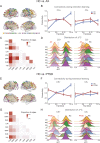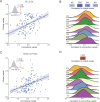Abnormal dynamic functional connectivity during fear extinction learning in PTSD and anxiety disorders
- PMID: 35145227
- PMCID: PMC9126814
- DOI: 10.1038/s41380-022-01462-5
Abnormal dynamic functional connectivity during fear extinction learning in PTSD and anxiety disorders
Abstract
Examining the neural circuits of fear/threat extinction advanced our mechanistic understanding of several psychiatric disorders, including anxiety disorders (AX) and posttraumatic stress disorder (PTSD). More is needed to understand the interplay of large-scale neural networks during fear extinction in these disorders. We used dynamic functional connectivity (FC) to study how FC might be perturbed during conditioned fear extinction in individuals with AX or PTSD. We analyzed neuroimaging data from 338 individuals that underwent a two-day fear conditioning and extinction paradigm. The sample included healthy controls (HC), trauma-exposed non-PTSD controls, and patients diagnosed with AX or PTSD. Dynamic FC during extinction learning gradually increased in the HC group but not in patient groups. The lack of FC change in patients was predominantly observed within and between the default mode, frontoparietal control, and somatomotor networks. The AX and PTSD groups showed impairments in different, yet partially overlapping connections especially involving the dorsolateral prefrontal cortex. Extinction-induced FC predicted ventromedial prefrontal cortex activation and FC during extinction memory recall only in the HC group. FC impairments during extinction learning correlated with fear- and anxiety-related clinical measures. These findings suggest that relative to controls, individuals with AX or PTSD exhibited widespread abnormal FC in higher-order cognitive and attention networks during extinction learning and failed to establish a link between neural signatures during extinction learning and memory retrieval. This failure might underlie abnormal processes related to the conscious awareness, attention allocation, and sensory processes during extinction learning and retrieval in fear- and anxiety-related disorders.
© 2022. The Author(s).
Conflict of interest statement
Praxis Precision Medicines, Inc. provides partial salary support to EPS. The remaining authors declare no competing interests.
Figures





Similar articles
-
Deficient fear extinction memory in posttraumatic stress disorder.Neurobiol Learn Mem. 2016 Dec;136:116-126. doi: 10.1016/j.nlm.2016.09.016. Epub 2016 Sep 26. Neurobiol Learn Mem. 2016. PMID: 27686278
-
Skin Conductance Responses and Neural Activations During Fear Conditioning and Extinction Recall Across Anxiety Disorders.JAMA Psychiatry. 2017 Jun 1;74(6):622-631. doi: 10.1001/jamapsychiatry.2017.0329. JAMA Psychiatry. 2017. PMID: 28403387 Free PMC article.
-
Association of Resting Metabolism in the Fear Neural Network With Extinction Recall Activations and Clinical Measures in Trauma-Exposed Individuals.Am J Psychiatry. 2016 Sep 1;173(9):930-8. doi: 10.1176/appi.ajp.2015.14111460. Epub 2016 Feb 26. Am J Psychiatry. 2016. PMID: 26917165
-
From Pavlov to PTSD: the extinction of conditioned fear in rodents, humans, and anxiety disorders.Neurobiol Learn Mem. 2014 Sep;113:3-18. doi: 10.1016/j.nlm.2013.11.014. Epub 2013 Dec 7. Neurobiol Learn Mem. 2014. PMID: 24321650 Free PMC article. Review.
-
Fear and safety learning in anxiety- and stress-related disorders: An updated meta-analysis.Neurosci Biobehav Rev. 2025 Feb;169:105983. doi: 10.1016/j.neubiorev.2024.105983. Epub 2024 Dec 18. Neurosci Biobehav Rev. 2025. PMID: 39706234 Review.
Cited by
-
Human fear neurobiology reimagined: Can brain-derived biotypes predict fear-based disorders after trauma?Neurosci Biobehav Rev. 2023 Jan;144:104988. doi: 10.1016/j.neubiorev.2022.104988. Epub 2022 Dec 5. Neurosci Biobehav Rev. 2023. PMID: 36470327 Free PMC article. Review.
-
Brain network changes in adult victims of violence.Front Psychiatry. 2023 Feb 2;14:1040861. doi: 10.3389/fpsyt.2023.1040861. eCollection 2023. Front Psychiatry. 2023. PMID: 36816407 Free PMC article.
-
Acute stress yields a sex-dependent facilitation of signaled active avoidance in rats.bioRxiv [Preprint]. 2024 Apr 29:2024.04.27.591470. doi: 10.1101/2024.04.27.591470. bioRxiv. 2024. Update in: Neurobiol Stress. 2024 Jun 13;31:100656. doi: 10.1016/j.ynstr.2024.100656. PMID: 38746268 Free PMC article. Updated. Preprint.
-
The neural circuits and molecular mechanisms underlying fear dysregulation in posttraumatic stress disorder.Front Neurosci. 2023 Dec 5;17:1281401. doi: 10.3389/fnins.2023.1281401. eCollection 2023. Front Neurosci. 2023. PMID: 38116070 Free PMC article. Review.
-
Causally mapping human threat extinction relevant circuits with depolarizing brain stimulation methods.Neurosci Biobehav Rev. 2023 Jan;144:105005. doi: 10.1016/j.neubiorev.2022.105005. Epub 2022 Dec 19. Neurosci Biobehav Rev. 2023. PMID: 36549377 Free PMC article. Review.
References
-
- Shalev A, Liberzon I, Marmar C. Post-traumatic stress disorder. N. Engl J Med. 2017;376:2459–69. - PubMed
Publication types
MeSH terms
Grants and funding
LinkOut - more resources
Full Text Sources
Medical

